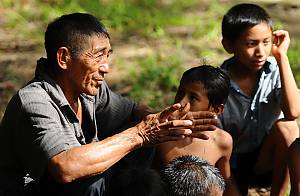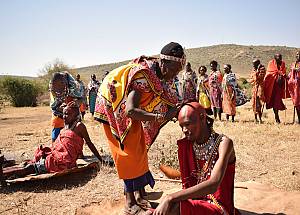
© Centro de la Diversidad, 2013
Indigenous peoples hold a rich diversity of living heritage, including practices, representations, expressions, knowledge and skills. The practice and transmission of this heritage contributes to the ongoing vitality, strength and wellbeing of communities.
To that end, the Convention provides an important opportunity for indigenous peoples to shape the international heritage discourse and ensure that their experiences and needs in safeguarding living heritage are taken into account.
Its Preamble recognizes that ‘communities, in particular indigenous communities, groups and, in some cases, individuals, play an important role in the production, safeguarding, maintenance and recreation of the intangible cultural heritage.‘

International Decade of Indigenous Languages
The United Nations proclaimed the period between 2022 and 2032 as the International Decade of Indigenous Languages Indigenous languages are a vehicle of living heritage. They are vital for the transmission of traditional knowledge passed on from generation to generation.
How to get involved
For indigenous peoples, there are many ways to get involved in the Convention.
- Community-based inventorying: Inventorying involves identifying and defining elements of intangible cultural heritage always with the view to safeguarding. Community involvement is mandatory and countries must ensure the widest possible participation of communities, groups and relevant non-governmental organizations in the inventorying process.
- Lists of the Convention: The Convention has a number of Lists to help safeguard different aspects of living heritage. All proposals to the Lists of the Convention must be made with the widest possible participation and free, prior and informed consent of the communities.
- Technical and financial assistance: Technical and financial assistance is available to support communities in their safeguarding measures through the Intangible Cultural Heritage Fund.
- Capacity-building programme: The programme provides the skills and knowledge needed to implement the Convention at the country level with the support of a global network of facilitators.
- Non-governmental organizations: Indigenous non-governmental organizations with recognised competence in intangible cultural heritage can request accreditation.
Frameworks for engagement
- The Ethical Principles for Safeguarding Intangible Cultural Heritage were elaborated in the spirit of the Convention and existing international normative instruments protecting human rights and the rights of indigenous peoples.
- The UNESCO Policy on Engaging with Indigenous Peoples guides the Organization’s work, in all areas of its mandate that involve or are relevant for indigenous peoples and of potential benefit or risk to them. It ensures that the Organization’s policies, planning, programming and implementation uphold the United Nations Declaration on the Rights of Indigenous Peoples.
Indigenous peoples’ involvement with the 2003 Convention

© Danson Siminyu, Kenya, 2010
Indigenous languages
Indigenous knowledge, encased in language, is often transmitted and expressed through a myriad of practices and expressions. The disappearance of a language threatens the continued practice and transmission of living heritage and may result in the loss of vital cultural and ecological knowledge.
Community-based resilience
Living heritage contains locally-rooted knowledge that can provide a source of resilience against changing climatic conditions.
Quality education
Quality education is important for safeguarding intangible cultural heritage. Integrating indigenous language and knowledge into education programmes can enhance the intergenerational transmission of living heritage.
Environmental sustainability
Living heritage can help protect biodiversity. Many local and indigenous communities have developed lifestyles and practices that are closely linked to nature and that respect the environment.
Related activities
Presentation of the 2003 Convention at UN Permanent Forum on Indigenous Issues
On 22 April 2019, the Living Heritage Entity organized a roundtable discussion on the sidelines of the United Nations Permanent Forum on Indigenous Issues (UNPFII) on “The Convention for the Safeguarding of the Intangible Cultural Heritage: Opportunities for Indigenous Peoples.”